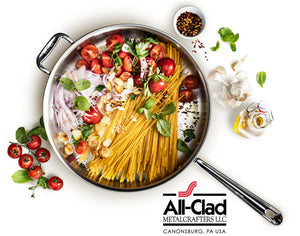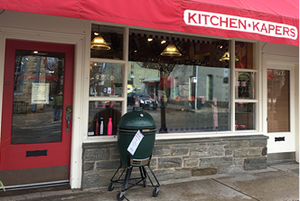Know your knives!
The two major methods of knife manufacturing are Forged and Stamped.
Forged knives are considered the best-quality. Each one is made individually from individual pieces of metal and molded under extreme heat to create their shape. Forged knives can be shaped from spine to edge and from handle to tip to best suit the style and ultimate purpose of a knife. As a result these blades are designed to be more durable, balanced, and will typically hold a sharp edge longer.
Stamped knives are punched out by a cookie-cutter-type machine. They are usually the same thickness from the spine through the width of the blade until the bevel begins to create the cutting edge. They don't have bolsters but can have full or partial tangs. Although this is the method used to produce the most inexpensive kitchen knives, some stamped knives are capable of very good quality and performance. Examples with full tangs and quality riveted or molded handles should last many years with the proper care.
Anatomy of a Knife:
Bolster: A thick band of steel on forged knives that helps make the transition from handle to blade. It helps balance the knife, strengthens the blade and offers additional stability in handling. Bolsters are usually only present on forged knives.
Edge: The sharp part of the blade. The edge can be formed by beveling both sides of the blade evenly or a single side of the blade. Many traditional Japanese blades are beveled on only one side, while Western blades and many newer Japanese styles are beveled on two sides.
Handle: Scales are the parts of the handle that join together over the tang to create its grip; the butt is the end.
Heel: The part of the cutting edge closest to the handle, it cuts through large or tough foods when you press down hard. Not all types of knives have a working heel, namely fillet and boning knives
Spine: The top, dull side of the blade, opposite the edge. The spine of forged knives will typically taper from handle to tip, where as stamped knives will most often be of a uniform thickness.
Tang: The part of the blade that extends into the handle, securing it and giving the knife balance. There are 3 types of tang design: partial, rat-tail and full. Full tangs offer the best balance and are a good sign of quality. Partial and rat-tail tangs do not indicate poor quality by themselves, but they are a cheaper method that is typically used for inexpensive knives.
Tip: The forward quarter of the blade. It should be the thinnest, and therefore sharpest part of the blade, best for cutting small or delicate foods. The point is also good for piercing. Some cleaver shaped blades do not have a tip
Popular Knife Types
Boning- an ideal kitchen knife for removing meat from bones and cutting fish or poultry. Boning knives can have different widths of blades as well as varying stiffness. The curve of the blade and very thin tip offers greater control when making precise cuts. Correctly used, the tip of a boning knife gets all the work.
Bread- a serrated knife used for cutting loaves of bread. Bread knives generally have 8" to 10" blades with serrated edges for cutting through thick, hard crust. The serrations on a bread knife are also useful for cutting tomatoes, pineapples and other tough skinned fruits and vegetables.
Chef's- one of the primary kitchen knives, it can be used for everything from chopping, mincing and butchering to slicing fruits and vegetables. Most chef's knives have a broad blade that curves upward towards the tip to allow the knife to rock for fine mincing. The spine of the blade is thick to add weight and strength. Forged chef's knives have a bolster, or metal collar, between the blade and handle. The bolster helps provide balance and strength and improves handling of the knife. Chef's knives come in blade lengths of 6", 8", 10", and 12". Longer blades can be more difficult to manage for some, but make for faster cuts. Shorter blades allow for greater control, and are generally suited to cooks with small hands. The two major design types of Western Chef's Knives are French and German. The French Chef's Knife is traditionally narrower with a gently curved edge and spine that meet at the tip; a German Chef's Knife is generally wider with more deeply curved edge and straighter spine.
Chinese Cleaver- is a wide-bladed, thin-spined knife that can be used to chop through meat and vegetables, and like the santoku, its deep blade is good for scooping ingredients into cookware. Chinese cleavers are good for tenderizing meat and crushing garlic, and other tasks that involve slicing. Despite its somewhat clumsy appearance, cooks who are adept with a Chinese cleaver can perform surprisingly delicate tasks, such as the boning out of small game birds! But one should never use a Chinese cleaver to cut bones since the blade is thinner.
Deba- a traditional Japanese knife with a thick, triangular wedge-shaped blade for butchering fish and poultry. Typically only one side is beveled and it's forged from carbon steel. Some modern styles include stainless construction with thin blades. Traditional styles can be tricky to get the hang of.
Fillet- Very similar in shape to a boning knife, but often has a longer, narrower blade. Fillet knives are likely to have flexible blades to provide tactile feedback and a more forgiving disposition when separating delicate fish fillets from bones.
Gyuto- very similar in appearance and use to the Chef's knife but with a thinner, lighter blade. There is less of a standard in the curvature of the edge or spine in this group, so don't be thrown by the variety of shapes. Instead, be sure to hold one before making the decision to buy. To achieve a thinner blade with a sharper edge, the Gyuto is often made from harder steels such as carbon steel or designer stainless steels. They can be spectacularly sharp...but also somewhat delicate, so don't use this knife on bones or hard vegetables like winter squash.
Meat Cleaver- a wide-bladed, thick-spined knife that can be used to cut through meat or poultry bones. The cleaver uses its weight to cut through tough food with a chopping motion. The thick, heavy blade on a cleaver is not meant for slicing, but its width makes it ideal for pulverizing meat, or crushing seeds or garlic.
Paring- a vital part of any set of kitchen knives. This small knife will usually have a thin 3 to 4 inch blade that usually tapers to a point. Paring knives are used for peeling and other intricate work and allow for a greater amount of control than a larger knife. In general, all paring knives (with the exception of the bird's beak) can be used for basic utility work in the kitchen.
Santoku- the Japanese version of the chef's knife. The Santoku is excellent for chopping vegetables and the wide blade works well for scooping sliced food off a cutting board. The Santoku can also be used to slice meat, and has a narrow spine for making thin cuts. Because it is a knife that excels at slicing, chopping, and mincing, santoku translates roughly to "three virtues".
Sharpening Steel- a hardened steel rod tapered to a point usually with a protective guard and handle. The rod can be smooth or lined with grooves of fine or coarse design running parallel to the rod length. The tip of the steel is generally magnetic to catch any stray metal that may be dislodged from the edge of the knife being sharpened. A traditional Sharpening Steel actually doesn’t do much sharpening (as defined by removing metal from the blade edge). What a Steel really does is the straighten the ultra-fine cutting edge, (you could even say on a molecular level- yes, really!) resulting in better cutting performance.
Slicing/Carving- Carving and Slicing knives are generally used for slicing meats, on or off the bone. These knives have long, thin and narrow blades with pointed tips, although certain longer roast beef and salmon slicers are made with rounded tips. Blades of this shape are ideal for making clean, continuous, thin slices through boneless sections of meats, poultry, fowl and fish. Slicing and Carving knives can be 8 to 14 inches long, and some slicing and carving knives will also have a "granton" edge (aka hollow-ground), which further reduces drag while slicing. A person who is skilled with such a knife can cut certain cooked or cured meats, salmon and ham so thin, you can practically see through them.
Tomato- similar to the bread knife except it is smaller and the serrations are finer. The blade will have a serrated edge for easily cutting through tough skin and a forked tip that can gouge out stems, pick up slices of food or poke the last pickle from a jar. This is a handy knife that makes a good alternative to the Utility knife.
Tourne- (aka bird's beak paring) a small type of paring knife that was initially designed for creating a specific garnish called a "Tourne". However, this knife can be used for peeling, garnishing, and for intricate melon carving. The pointed tip is useful for removing strawberry stems and tomato stems.
Usuba- (also Nakiri) a traditional Japanese knife with a thick rectangular blade designed for slicing vegetables. Typically only one side is beveled and it's forged from carbon steel. Traditional styles have very thick blades that take skill to use and maintain, but some modern styles include designer stainless construction with thin blades.
Utility- mid-sized knives used for a variety of miscellaneous cutting jobs. The blade is anywhere from 4 to 7 inches, larger than a paring knife but not as large or wide as a chef's knife. The blade is usually more slender and maneuverable. A utility knife is good for cutting vegetables and sandwich meats that are not large enough for a chef's knife. These knives can come in plain and serrated edges, and are sometimes referred to as "sandwich knives".
Yanagi- a traditional Japanese knife with an extra-long and narrow blade designed for pull-slicing sashimi. The edge is beveled on one side and relatively straight to the tip. Traditionally made from carbon steel but many are also made from high carbon stainless steel or Damascene-type construction. Spine widths and tip shape can vary but they are always made to be unrelentingly sharp, meant for the pristine and precise slicing of raw fish for sushi preparation. Yanagi means "willow blade" and it is the preferred tool for making cross-cut slices.



